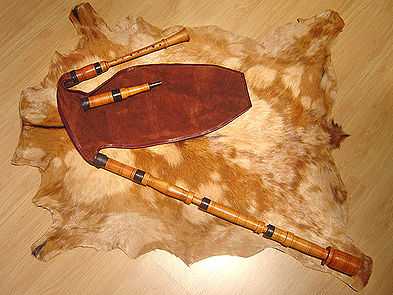Gaita transmontana

The gaita de foles mirandesa (wrongly called the gaita transmontana) is a type of bagpipe native to the Trás-os-Montes region of Portugal.
History
The most ancient records of this instrument date from the 18th century, mostly written. Its culture has been passed since then from father to son until the 20th century, with some small differences from region to region. In Portugal, it can be found mainly in Trás-os-Montes region, specially in Vinhais, Bragança, Miranda and Mogadouro, but also in Guarda and Castelo Branco. Some Portuguese regiments from Minho, Trás-os-Montes and Guarda used the bagpipes to mark the marching cadence, although the standard marching pattern of the Portuguese infantry regiments was the same as the French. Northern Portugal, specially above the Douro river, is a very mountainous region, where the sound of bagpipes can be heard miles away due to the resonance effect created by the oppressive humidity and altitude. The gaita transmontana has a peculiarly grave tone, which resulted in an awkwardly low pitch. In fact, numerous written records of French commanders during the Peninsular War noted the intimidating effect the sound had on foot soldiers, specially at night, unfamiliar with such sound.
Only recently this type of bagpipe has been recovered through the gathering of repertoires, aided by the promotion of the instrument from several bagpipe associations from Portugal and Galicia.
External links
- Sobre a gaita transmontana
- Estudo e Construção da Gaita transmontana no Brasil - Study and Maker of the instrument in Brazil